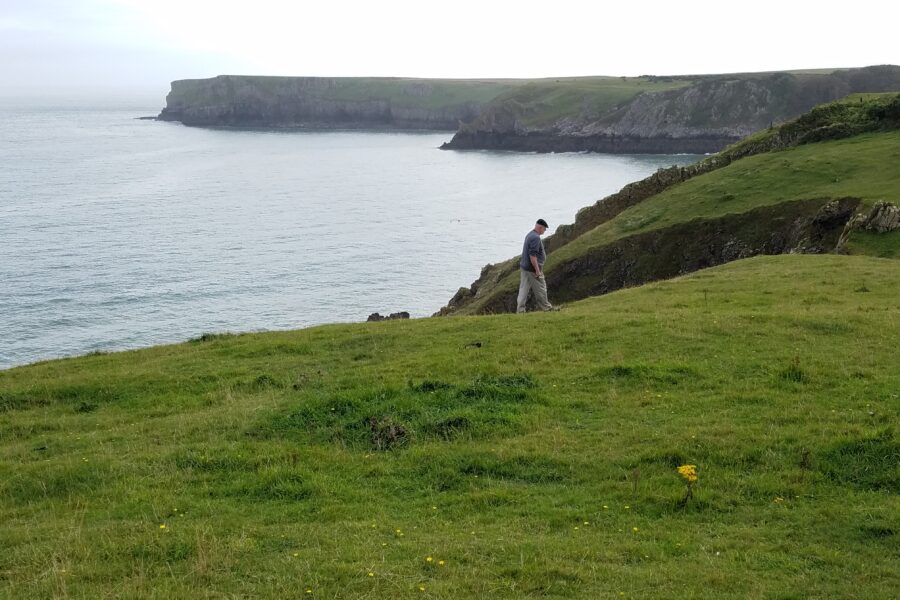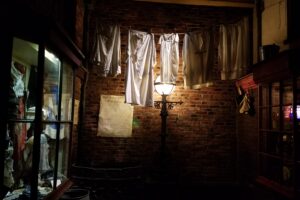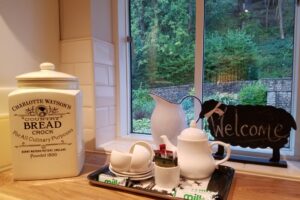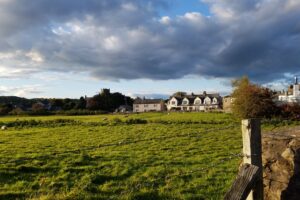
Pembroke Castle
To get to the castle we need to walk uphill. To explore the castle we need to climb steps. This is the story of my life in Great Britain. I’m surprised all those knights and raiders and soldiers and pillagers of so long ago had the energy left to fight once they got near their target.
The castle, founded in the 11th century and rebuilt in the late 12th century, was witness to the rise and fall and deaths of kings through the ages who sometimes used it as a bargaining chip to gain or reward loyalty; King Henry VII was even born here. Ascending the ancient outside steps from the expansive courtyard we enter real rooms with worn wood floors. We crash a feast and walk into a battle during the English Civil War, the era that signaled the doom of this ancient fortress. There are signs on the walls that tell the story.
Pembroke castle does more than share its ancient stone walls, it says come with me, walk through my rooms, let me show you how it was to be me for the last one thousand years. Michael and I both get additional history lessons sitting on hard benches in dark damp dungeons watching ever-changing cartoon drawings on walls while absorbing the stories that go with them. He climbs to the top of towers and I listen to more stories of knights whose fortunes were tied to the castle, their life-size images attached to the castle walls, .







Interior of the five story tower. Home to unseen, but noisy birds, that fly and flutter as Michael climbs the interior, winding stairway making his way to the top.



Even though the castle was abandoned in 1648, when Oliver Cromwell ordered it to be destroyed while encouraging townspeople to tear it down and reuse the stone for themselves, it survives today—somebody in later centuries cared. A decaying ruin till 1880, a three year restoration project was undertaken; in 1928 when a titled major general acquired the castle further restorations took place, leaving an amazing example of a medieval fortress for Michael and me to explore—just us.


Photograph taken from the top of the five story tall large round tower in the middle of the courtyard.
Missing our noontime meal yesterday because we ignored the 12 p.m. – 2:30 p.m. window, we ask directions to a close by pub that serves lunch. We are guided to The Old Kings Arms down another hill, barely a breath away. I order an onion thing for a starter because I never heard of it and want to know what it is—and it is onions after all, how bad can it be? And since it is Sunday, the only entrees on the menu are their Sunday Roast—beef, lamb, pork, or a mixture of all three. Michael tells me I have to order lamb, because I have been eating fish all week and according to Ian, Welsh lamb is supposed to be the best. The servings are massive, and the lamb is ultra delicious. I love the creamed leeks and the onion bahji is good—Indian comfort food—redolent of curry and cumin.




While we eat and drink and make merry I tell Michael all about the dinner I have planned for his birthday celebration tomorrow when we are in the Cotswolds. “But my birthday is today,” he tells me. I panic thinking I have made reservations at the Wheatsheaf Inn for the wrong day; he tells me he has already checked the timing and we’re OK. I settle in to profuse apologies. I have never been so disoriented date and day wise in my life. It may have something to do with our constant relocating; packing and unpacking and repacking—totally not part of our MO when we travel.
Back in the car I show him pictures of the Pembrokeshire coast. He agrees it is beautiful, but too far away. “Not really,” I say. Google maps says it is only four-and-a-half miles away. A mere eleven minutes. Driving to the end of the road, we really don’t know where to go from here, so Michael says, “I’m going to follow that car.”
We wind up in a car park that has a National Trust sign. There is someone taking money for admittance, but because we are National Trust members, and foreigners, the individual spends time with us explaining where we are, what we should see, and how to get there. The weather has turned mild and sunny and we start our walk—climbing stairs. We reach the end of one trail and follow another, a coastal footpath, that takes us through green fields that frost towering cliffs rising above the crashing waves below. Maybe this is turning out to be a good birthday after all—I hope.




Sitting on the damp emerald colored ground high above the Atlantic, Michael mentions that he wants to see St. Govan’s Chapel; a place we heard about during our Welsh evening at St. Bride’s Castle. Returning to our car I get to play Jeeves telling Michael which way to turn and when. He doesn’t appreciate me as a substitute and it is all touch and go for awhile—till I get us there. We leave the car, not looking around for signs and follow the path populated with people walking. At the end of the trail there is nothing but a huge giant bunker.

Michael hates it, but I check my phone. “We are way off the mark,” I say, “St. Govan’s is back there—where we parked.” By the time we get to the path where you descend 75 steps to the chapel we have walked a long, long way. I decide to opt out of this adventure—my right foot screaming at me to stop and sit down somewhere. So I do.

It seems hours since Michael has descended into the depths, skirting the edge of the small building wedged between the cliffs; others follow—they too are swallowed by the chapel or the sea or… I am ready to start my descent to see what in the world has happened to everyone when I see Michael climbing up out of the hole.
I’m glad he’s back.

The poem by Arthur Glyn Prys-Jones, that inspired Michael to want to see St Govan’s Chapel, read to us at St. Bride’s during Welsh night. Photos of his tiny secret citadel are below.
St Govan, he built him a cell
By the side of the Pembroke sea,
And there, as the crannied sea-gulls dwell.
In a tiny, secret citadel
He sighed for eternity.
St Govan, he built him a cell
Between the wild sky and the sea,
Where the sunsets redden the rolling swell
And brooding splendour has thrown her spell
On valley and moorland lea.
St Govan still lies in his cell,
But his soul, long since, is free,
And one may wonder – and who can tell –
If good St Govan likes Heaven as well
As his cell by that sounding sea?





And Who Was Saint Govan—I really needed to know more, and according to Wikipedia:
Saint Govan (Welsh: Gofan) (died 586) was a hermit who lived in a fissure on the side of coastal cliff near Bosherston, in the Pembrokeshire Coast National Park, Wales. St. Govan’s Chapel was built in the fissure in the 14th century on what is now known as St. Govan’s Head.
Legends
One story says Govan was an Irish monk who travelled to Wales late in life to seek the friends and family of the abbot who had trained him, variously identified as Saint David or Saint Ailbe of Emly. Another story identifies Govan with Gawain, one of King Arthur’s Knights of the Round Table; another that he was originally a thief.
Govan was set upon by pirates, from Ireland or the nearby Lundy Island. The cliff opened up and left a fissure just big enough for him to hide in until the pirates left. In gratitude, he decided to stay on along the cliff, probably to help warn the locals of the impending pirate attack if they were to return.
St Govan lived within a small cave in the fissure of the cliff. This is now reached by a long flight of stone steps, the number of which is said to vary depending on whether one is ascending or descending.
The present small vaulted chapel of local limestone was built over the cave and dates from the 13th century although the site may have been of monastic importance since the 5th century. St Govan may be identified with Sir Gwaine, one of King Arthur’s knights, who entered into a state of retreat in his later years. Originally St Govan caught fish and took water from two nearby springs. Both are now dry; one was where the medieval chapel now stands, the other, which was lower down the cliff, later became a holy well. A legend says St Govan’s hand prints are imprinted on the floor of his cave and his body is buried under the chapel’s altar. The cave was once a popular place for making wishes.













Leave a Reply
Your email is safe with us.